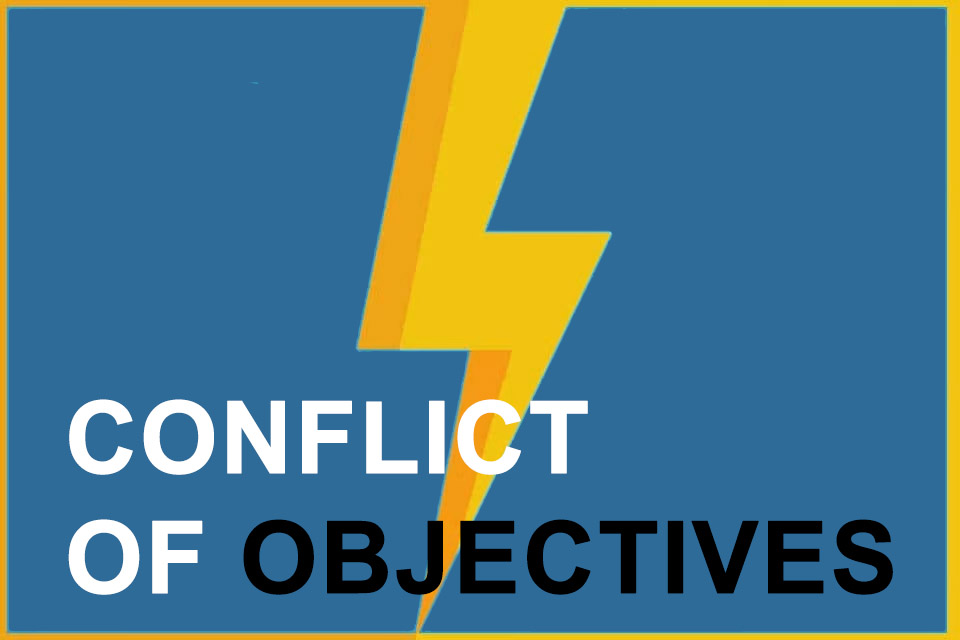What is a Conflict of Objectives?
Smartpedia: A conflict of objectives exists when objectives are in competition with each other and therefore cannot be achieved in full.
Conflict of objectives definition
A objective describes a future state that differs from the present state and is worth striving for. A conflict of objectives exists when individual objectives contradict each other in part or as a whole and cannot be fully achieved as a result. In other words, there is a competing relationship between the goals – also referred to as goal rivalry. The desirable, positive counterpart is a compatible goal relationship.
In corporate practice, conflicting goals are nothing unusual. Wherever people meet and pursue different interests based on their values, motives and ideas, conflicts are the order of the day. The exciting question is therefore: How can conflicting goals be resolved in the smartest and most meaningful way possible?
What are the different types of conflicting objectives?
There are different types of conflicting objectives. Probably the most common and widespread interpretation names two types:
- intrapersonal and
- interpersonal conflicts.
An intrapersonal conflict is when a company or even an individual cannot achieve all desirable goals at the same time. As the name implies: the conflict lies “in” the company or in a person himself. This is hardly surprising: people are contradictory and often pursue conflicting aims. And since an organisation is a collection of people, conflicting goals are the rule rather than the exception. It is easy to want both A and B, but if A and B contradict each other even in part, there is a conflict. For example, an employee wants job security with an established company, but after 15 years with his employer, he can imagine moving to a start-up company where he could earn more. Job security (A) and better pay (B) as a result of the change of employer are thus in a competing target relationship. (Read more about this under “Eliminating conflicting objectives”.)
An interpersonal conflict exists when several economic entities – i.e. states, companies, households, individuals, stakeholders, etc. – pursue goals that contradict each other. Example: A state has an interest in a high level of employment, companies aim to maximise profits and may therefore relocate jobs to more favourable locations.
The sociology of social conflict¹ recognises three variants of intrapersonal goal conflicts:
- In the case of equivalence conflict, an economic subject must decide between two comparable, positive options. Example: Since only limited financial resources or only limited capacities of labour are available, two new machines cannot be purchased at the same time or two projects can be carried out in parallel. Ergo: a decision must be made for a course of action, an investment or a goal.
- In the ambivalence conflict – also known as appetence-aversion conflict² – the goal has both positive and negative manifestations. Example: the magic triangle in project management includes three goal dimensions: Time, Cost and Quality. If a company wants to bring a new product to market as quickly as possible (time factor) and with a minimum set of functions (cost factor), then quality will be comparatively low. If, on the other hand, the company decides to wait until the product is of high quality before launching it on the market, costs will rise and the time of market entry will be postponed.
- In the case of the vitation conflict, goals have exclusively negative characteristics. Example: Should an old but important system of a company be maintained and serviced or does it make more sense to invest in a new system. In practice, it can be observed that many organisations opt for the principle of the lesser evil and are thus subject to the so-called “sunk cost fallacy”.³
There is also another perspective to determine different types of conflicting targets. To do so, it is sufficient to look at different types of objectives. There are, among others:
- monetary and non-monetary or quantitative and qualitative objectives,
- main and secondary or overall and sub-objectives,
- strategic and operational or long-term, medium-term and short-term goals.
Between all these characteristics there can be conflicts of objectives: between monetary and non-monetary, or monetary and monetary, or non-monetary and non-monetary, between medium- and long-term, or strategic and operational, or between operational and monetary objectives, etc. The interesting thing about this perspective is that it is a useful complement to intrapersonal and interpersonal considerations in corporate reality when eliminating conflicts of objectives.
Elimination of conflicting objectives
How can conflict of objectives be resolved as smartly and sensibly as possible? Of course, it depends on the specific situation. Example (from above): An employee wants job security and better pay. He could now a) change employer and get more pay, but would exchange a secure employment relationship with a new and thus rather insecure one. Or he could b) discuss his situation with the existing employer and subsequently receive more salary from the latter. Possibly, despite the increase, the salary is lower than with the new employer, but the secure job remains.
Two lessons emerge from this example:
- the weighting and subsequent prioritisation of goals is one way of dealing with conflicting objectives.
- the resolution of conflicting objectives always requires a decision. For this reason, too, it is important to know and master decision-making techniques.
In the practice of organisations, dealing with intrapersonal conflicts is not quite as simple as in the example just given. It therefore makes sense to classify the different goals in a first step and then to group them. A prerequisite for this is a detailed stakeholder identification and stakeholder analysis.
Why: The goal of an “important” stakeholder should be given greater priority than the goal of a less important stakeholder.
How: For example, in the form of workshops or through individual interviews.
Result: a list of goals (of different stakeholders).
Then the actual task begins, i.e. the classification of the goals, e.g. on the basis of objective relationships:
- identical,
- antinomian,
- indifferent,
- complementary and
- competing goals.
Especially in larger organisations, it can easily happen that goals are formulated with different words but with identical intentions and orientation. Example: A company wants to offer the best possible support and a hotline around the clock. (Depending on the interpretation, this could also be an intermediate goal; see objective relationships). Goal identity should of course be avoided.
Goal antinomy is when two goals are completely mutually exclusive. It corresponds to the maximum expression of competing goals. Example: a sales manager wants to increase the number of customers’ maintenance contracts and at the same time cancel maintenance agreements with smaller volumes. Or: friends want to found a non-profit organisation, others want to build a profit-oriented company.
Indifferent objectives have no relationship to each other, they are neutral. Example: a sales manager wants to improve the onboarding of new employees who start work in the home office. At the same time, he wants to boost the cross-selling of products through a targeted marketing campaign. Objective indifference usually does not require explicit action.
Complementary goals are relatively comfortable to handle because they complement each other. In such a case, we speak of so-called target harmony. Example: a sales manager wants to reduce the sickness rate and staff turnover. At the same time, he would like to improve the work equipment in the home office to enable cross-selling of products through high-performance access to all customer data via CRM.
The challenge for many organisations lies in dealing with competing objectives. At this point, at the latest, the procedure in organisations varies. It would be conceivable, for example, to group them according to the types of goals, e.g.
- the time horizon of the goal (short, medium or long term),
- the operational or strategic importance,
- quantitative or qualitative relevance, or
- the monetary or non-monetary impact.
Whether it makes sense to mix the groups and present them in the form of a goal matrix, to use goal diagrams to define goal hierarchies with upper and lower goals, or simply to define three strategic goals and implement a strategy by means of OKR, cannot be universally determined. Nevertheless, there are some tips for dealing with conflicting objectives.
Tips for Dealing with Conflict of Objectives
Here are some tips on how to deal with conflicting goals:
- Conflicts often arise in companies because goals are not clearly formulated and communicated. Hidden, unspoken goals can have far-reaching consequences for the success of developments or the definition of products and services. Therefore, structured goal identification is important.
- The prerequisite for consciously eliminating conflicts is knowing about them. Conflicts of objectives can only be addressed if they are known. So identifying targets is only one step, which should be followed by an analysis. What is the importance of the goal for individuals, departments, divisions or the whole company? What are the reasons for it? What connections might there be? The better the background is understood, the more information can be used to find a concrete solution to the conflicts.
- Open discussion about the conflicts, as well as how to deal with them and possibly eliminate them, is very important. Here it can be useful to look at different forms of decision-making such as consensus and consent.
- Competing or even antimonious goals do not disappear by themselves. Negating them is not a good idea.
Opinions vary in organisations as to whether defined rules or rather principles are better suited to eliminate conflicting goals. Depending on preference, both can help, although it should always be noted that many markets and situations are volatile, so that on the one hand a flexible application of rules or principles can make sense, and on the other hand said rules and principles should also be checked again and again for their effect and meaningfulness.
[1] Can conflicting goals be eliminated at all or are they in fact merely structured, hierarchised, prioritised and discussed? Do they therefore continue to exist even if there is an agreed procedure within an organisation?
[2] Some publications state that a conflict of objectives exists when objectives cannot be achieved simultaneously. However, operational and strategic goals can never be achieved at the same time. Ideally, the achievement of operational goals “pays into” the strategic goal. This eliminates the “simultaneity” argument, doesn’t it?
Notes (partly in German):
[1] Soziologie des sozialen Konflikts
[2] Ambivalenzkonflikt
[3] Sunk Cost Fallacy using the example of a project termination
Here you will find additional information from our t2informatik Blog:



